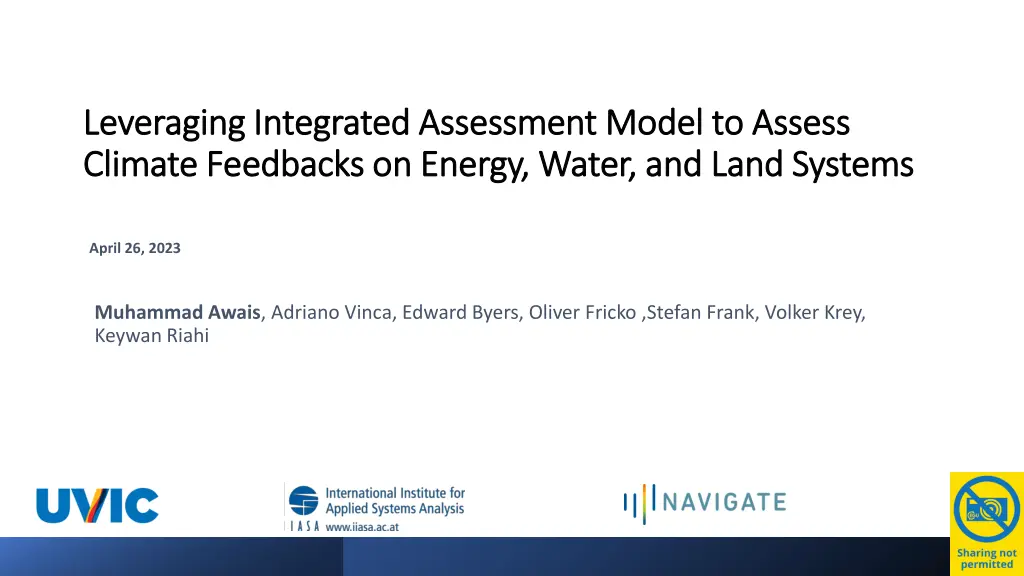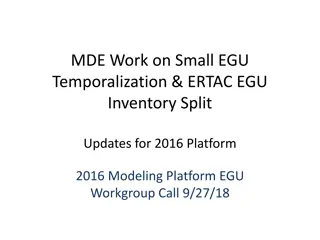
Assessing Climate Feedbacks on Energy, Water, and Land Systems for Sustainable Development
Explore the use of an Integrated Assessment Model to analyze climate feedbacks on energy, water, and land systems, emphasizing the importance of sustainable development pathways. Discover enhanced approaches to assessing economic implications and biophysical impacts across sectors in the context of climate resilience.
Download Presentation

Please find below an Image/Link to download the presentation.
The content on the website is provided AS IS for your information and personal use only. It may not be sold, licensed, or shared on other websites without obtaining consent from the author. If you encounter any issues during the download, it is possible that the publisher has removed the file from their server.
You are allowed to download the files provided on this website for personal or commercial use, subject to the condition that they are used lawfully. All files are the property of their respective owners.
The content on the website is provided AS IS for your information and personal use only. It may not be sold, licensed, or shared on other websites without obtaining consent from the author.
E N D
Presentation Transcript
Leveraging Integrated Assessment Model to Assess Leveraging Integrated Assessment Model to Assess Climate Feedbacks on Energy, Water, and Land Systems Climate Feedbacks on Energy, Water, and Land Systems April 26, 2023 Muhammad Awais, Adriano Vinca, Edward Byers, Oliver Fricko ,Stefan Frank, Volker Krey, Keywan Riahi
Understanding Climate Resilient Pathways Understanding Climate Resilient Pathways Better representation of adaptation in quantitative climate assessments [van Mannen et al. 2023 (Nature Climate Change)] Current development pathways, combined with the observed impacts of climate change, are leading away from, rather than towards, sustainable development, as reported in recent literature [AR6, WGII, Chapter 18] Previous Approaches: Top-down macro-economic assessment (damage functions, Social cost of carbon etc.) Multi-sectoral approach assessing economic implications and feedbacks across sectors: water, energy, land policy analysis with Integrated Assessment Model (MESSAGEix- GLOBIOM). Enhanced water sector representation Biophysical Impacts across sectors Scenarios considering climate impacts & SDGs 2
Scenarios Scenarios SDG measures Climate Impacts Reference scenario No Climate Impacts No SDGs Efficiency improvements, environmental flow constraints, piped water access, wastewater treatment Heathy (EAT-Lancet) diet, reduce food waste Impacts Hydrology: Precipitation pattern/runoff, groundwater intensity Crop Yield changes Renewable energy Cooling/heating demand Desalination potential Power plant cooling capacity Climate impacts (RCP 6.0) Maximized electrification, phase-out traditional bio, cooling gap Protected natural land (>30%) SDGs, Impacts & Adaptation Based on: ISIMIP 3b data, Byers et al., 2018, Gernaat et al., 2021 etc.) 2.6 W/m2 target SDGs Climate impacts (RCP 6.0) Based on: Doelman et al. 2022, MESSAGE-ACCESS, Van Vuuren et al., 2019, Parkinson et al., 2019, Frank et al., 2021, Hasegawa et al., 2015, Pastor et al., 2019 3
Climate Impacts: Hydrology Climate Impacts: Hydrology Large hydrological uncertainties with pronounced regional differences 8.40 billion people 8.41 billion people Climate Whiplashing - Impacts implies wetter and dryer basins based on geophysical conditions 0.18 billion people 0.24 billion people Sustainable & Non-sustainable adaptation options: - water recycling/treatment, - Desalination - Unsustainable groundwater extraction (depletion) Limitation: 5 year annual time step in IAM Aggregation bias Regional variation of wet and dry runoff for the basins 4
Some regions will gain yield, other will have yield losses. EPIC crop model (ISIMIP, CWatM input) MESSAGEix-GLOBIOM Adaptation options include crop shift, irrigation vs rainfed CO2 fertilization of crops have impacts in climate scenarios Responses to meet SDG 2 (diet), 15 crop choices and SDG6 (env flow) Yield also significantly impact water withdrawals and significantly water investments across scenarios Climate Impact: Climate Impact: Crop yields Crop yields Percentage difference of Crop Yields of a climate impact scenario from historical climate Adaptation Yields of land use output after land allocation and water constraints Impacts Yields calculated from crop models 5
Energy Water Energy use (Primary, Secondary, Final) Energy prices CO2emissions pathways Capacity requirements Energy supply portfolio A/C cooling gap Investment pathways Energy use of water commodities) Adjusted residential demands with increased access to electricity Water withdrawals based on constraints Water supply outlook (combination of different sources) Capacity requirements of of water infrastructure technologies (wastewater, water distribution) Investment in the water infrastructure sector Drinking & irrigation water marginal prices Water footprint of energy sector Key Indicators from Scenarios Land Socio-economics Water Withdrawals for Irrigation Crop Yields Land Cover (different categories) Agriculture production & demand Fertilizer use & intensity Land use CO2 emissions Population with access to drinking water, sanitation Urban & rural municipal demands Population with access to electricity, clean-cooking fuels Population with risk of hunger
Energy, Water, Land (Brief Outlook) Some regions show increase/decrease in CO2 emissions due to climate feedbacks Increased food prices globally due to impacts whereas SDGs with Impacts reduce food price. Water Resources vary mostly due to geophysical and hydrological conditions. Electricity withdrawals decrease due to climate impacts on cooling water for power plants. Yield & Irrigation withdrawals changes are due to endogenous adaptation and water constraints. Overall SDGs in combination with Impacts and adaptation have some co-benefits in The values represent percentage change of the indicator value from the reference (no climate , no SDG scenario) land sector (yields, food prices).
Investments Needs (Water) Withdrawals are mostly affected by land sector changes Increased water Infrastructure investments are due to increased access to piped connection in SDGs. Wastewater, desalination and fossil groundwater can be tracked as Adaptation Investments with fossil groundwater as maladaptation . Alternative water adaptation investments are higher in South Asia due to limited freshwater availability, lesser access to piped connection of water infrastructure. In terms of investments difference, renewable water changes are lesser compared to other The values represent average annual change from 2025-2100 of investments from the reference mitigation scenario (no climate , no SDG scenario) 8
Understanding the Water Sector Constraints Water Supply quantiles to see the reliability of monthly flow averaged over the year This in combination with SDGs could help understand the response on system due to sustainable extraction of surface water Scenarios with Q90, Q70, Q50 (flow exceeded 90%, 70%, 50% of the time) helps to see the renewable water supply portfolio A higher reliability scenario results in significant investments on alternative water (non-renewable fossil) Change in average annual costs from the low-reliability scenario to see how the sectoral outlook changes when the water system changes from low to medium and low to high reliability. 9
Final Comments A first step towards better integration of biophysical climate impacts in a process based IAM. Scenarios inform regional pathways addressing trade-offs between climate impacts and sustainable development objectives. Vulnerable regions have the challenge of adapting and achieving SDGs simultaneously thus increased investment needs. Improved representation of climate extremes and temporal granularity to better track the model responses. More model sensitivity to understand hydrological uncertainties and responses Model Description Paper Open for discussion For queries: awais@iiasa.ac.at https://egusphere.copernicus.org/preprints/2023/egusphere-2023-258/ 10



